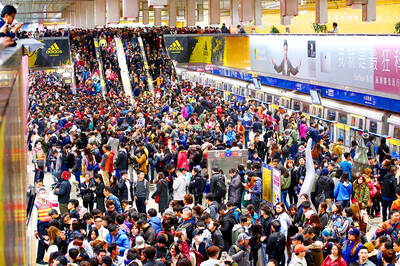The Hsinchu Forest District Office plans to file charges against the privately owned Taoyuan Irrigation Association over the organization’s alleged profiteering by occupying and leasing out four plots of public land covering more than 226,000m2 in a Shihmen Reservoir catchment basin.
The Water Resources Agency’s Geographic Data System shows that the plots are in the No. 4 National Forest, overseen by the Forestry Bureau.
The plots are close to Taoyuan’s Dasi District (大溪) and have a combined market value of about NT$140 million (US$4.44 million), the data showed.

Photo: Sean Lin, Taipei Times
An independent investigation by Green Formosa Front standing director Lin Chang-mao (林長茂) found that a mountain road leading to the plots had been fenced off twice, with a sign on a gate further down the road reading: “Fierce dogs inside. Do not enter.”
He said that suspected tenants have over recent years built a temple dedicated to the Four-Faced Buddha, which would likely be open to the public in the future.
A comparison of an aerial map in the system, created in 2013, and a more recent image from Google Maps found more potential illegal developments in the national forest, including two plots that used to have a high tree density.
While gathering evidence on one of the plots yesterday, Lin was confronted by a pack of dogs apparently there to scare off any “intruders.”
He was later confronted by the purported tenants, a man and a woman, who happened to be nearby.
When the man asked Lin what he was doing there, Lin countered by asking the man whether he knew that he was occupying public land.
The man denied the allegation, claiming that he leased the plot from the Taoyuan Irrigation Association.
“How dare you act so blatantly after I’ve caught you trespassing?” the man said to Lin.
Hsinchu Forest District Office official Chou Yi-che (周以哲) later rejected the man’s claim, saying that his agency is working to prosecute the association, which illegally leased the plots belonging to the Forestry Bureau.
He said that the agency would “definitely” take legal action against the association once it finishes assessing the structures, including the tarmac and concrete used in the construction of the temple.
He said that the temple would likely face demolition and the measurements are a reference to the areas that must be restored to their former states.
Chou’s remarks drew criticism from Lin, who said that it has been six months since he first informed the agency of the potential violations and that the agency has been slow to take action.
Asked to comment on the issue, Forestry Bureau Deputy Director-General Yang Hung-chih (楊宏志) said that by law, all temples built in national forests after July 1993 should be demolished.
The bureau would see to it that any illegal structures in the forest are demolished and all illegally occupied land vacated, he said.
Under the Forestry Act (森林法), only public infrastructure such as schools and hospitals, or facilities that can improve national defense, traffic or water distribution, may be built in national forests.

People can take the Taipei MRT free of charge if they access it at Nanjing Sanmin Station or Taipei Arena Station on the Green Line between 12am and 6am on Jan. 1, the Taipei Department of Transportation said on Friday, outlining its plans to ease crowding during New Year’s events in the capital. More than 200,000 people are expected to attend New Year’s Eve events in Taipei, with singer A-mei (張惠妹) performing at the Taipei Dome and the city government’s New Year’s Eve party at Taipei City Hall Plaza, the department said. As people have tended to use the MRT’s Blue or

Civil society groups yesterday protested outside the Legislative Yuan, decrying Chinese Nationalist Party (KMT) efforts to pass three major bills that they said would seriously harm Taiwan’s democracy, and called to oust KMT caucus whip Fu Kun-chi (傅?萁). It was the second night of the three-day “Bluebird wintertime action” protests in Taipei, with organizers announcing that 8,000 people attended. Organized by Taiwan Citizen Front, the Economic Democracy Union (EDU) and a coalition of civil groups, about 6,000 people began a demonstration in front of KMT party headquarters in Taipei on Wednesday, organizers said. For the third day, the organizers asked people to assemble

Taipei is participating in Osaka’s Festival of Lights this year, with a 3m-tall bubble tea light installation symbolizing Taiwan’s bubble tea culture. The installation is designed as a bubble tea cup and features illustrations of Taipei’s iconic landmarks, such as Taipei 101, the Red House and North Gate, as well as soup dumplings and the matchmaking deity the Old Man Under the Moon (月下老人), affectionately known as Yue Lao (月老). Taipei and Osaka have collaborated closely on tourism and culture since Taipei first participated in the festival in 2018, the Taipei City Department of Information and Tourism said. In February, Osaka represented

Taiwanese professional baseball should update sports stadiums and boost engagement to enhance fans’ experience, Chinese Professional Baseball League (CPBL) commissioner Tsai Chi-chang (蔡其昌) told the Liberty Times (sister paper of the Taipei Times) in an interview on Friday. The league has urged Farglory Group and the Taipei City Government to improve the Taipei Dome’s outdated equipment, including relatively rudimentary television and sound systems, and poor technology, he said. The Tokyo Dome has markedly better television and sound systems, despite being 30 years old, because its managers continually upgraded its equipment, Tsai said. In contrast, the Taipei Dome lacked even a room for referees